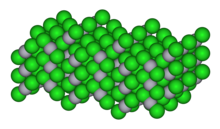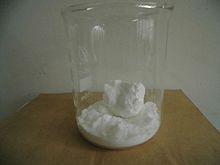
Back Kwik(II)chloried AF كلوريد الزئبق الثنائي Arabic کولورید جیوه (II) AZB Clorur de mercuri(II) Catalan Chlorid rtuťnatý Czech Сулема CV Quecksilber(II)-chlorid German Cloruro de mercurio(II) Spanish جیوه(II) کلرید FA Elohopea(II)kloridi Finnish
 | |
 | |
 | |
| Names | |
|---|---|
| IUPAC names
Mercury(II) chloride
Mercury dichloride | |
| Other names
Mercury bichloride
Corrosive sublimate Abavit Mercuric chloride Sulema (Russia) TL-898 Agrosan Hydrargyri dichloridum (homeopathy) | |
| Identifiers | |
3D model (JSmol)
|
|
| ChemSpider | |
| ECHA InfoCard | 100.028.454 |
| EC Number |
|
| KEGG | |
PubChem CID
|
|
| RTECS number |
|
| UNII | |
| UN number | 1624 |
CompTox Dashboard (EPA)
|
|
| |
| |
| Properties | |
| HgCl2 | |
| Molar mass | 271.52 g/mol |
| Appearance | colorless or white solid |
| Odor | odorless |
| Density | 5.43 g/cm3 |
| Melting point | 276 °C (529 °F; 549 K) |
| Boiling point | 304 °C (579 °F; 577 K) |
| 3.6 g/100 mL (0 °C) 7.4 g/100 mL (20 °C) 48 g/100 mL (100 °C) | |
| Solubility | 4 g/100 mL (ether) soluble in alcohol, acetone, ethyl acetate slightly soluble in benzene, CS2, pyridine |
| Acidity (pKa) | 3.2 (0.2M solution) |
| −82.0·10−6 cm3/mol | |
Refractive index (nD)
|
1.859 |
| Structure | |
| orthogonal | |
| linear | |
| linear | |
| zero | |
| Thermochemistry | |
Std molar
entropy (S⦵298) |
144 J·mol−1·K−1[1] |
Std enthalpy of
formation (ΔfH⦵298) |
−230 kJ·mol−1[1] |
Gibbs free energy (ΔfG⦵)
|
-178.7 kJ/mol |
| Pharmacology | |
| D08AK03 (WHO) | |
| Hazards | |
| Occupational safety and health (OHS/OSH): | |
Main hazards
|
Highly toxic, corrosive. |
| GHS labelling: | |
   
| |
| Danger | |
| H300+H310+H330, H301, H314, H341, H361f, H372, H410 | |
| P201, P202, P260, P264, P270, P273, P280, P281, P301+P310, P301+P330+P331, P303+P361+P353, P304+P340, P305+P351+P338, P308+P313, P310, P314, P321, P330, P363, P391, P405, P501 | |
| NFPA 704 (fire diamond) | |
| Flash point | Non-flammable |
| Lethal dose or concentration (LD, LC): | |
LD50 (median dose)
|
32 mg/kg (rats, orally) |
| Safety data sheet (SDS) | ICSC 0979 |
| Related compounds | |
Other anions
|
Mercury(II) fluoride Mercury(II) bromide Mercury(II) iodide |
Other cations
|
Zinc chloride Cadmium chloride Mercury(I) chloride |
Except where otherwise noted, data are given for materials in their standard state (at 25 °C [77 °F], 100 kPa).
| |
Mercury(II) chloride (or mercury bichloride[citation needed], mercury dichloride), historically also known as sulema or corrosive sublimate,[2] is the inorganic chemical compound of mercury and chlorine with the formula HgCl2, used as a laboratory reagent. It is a white crystalline solid and a molecular compound that is very toxic to humans. Once used as a treatment for syphilis, it is no longer used for medicinal purposes because of mercury toxicity and the availability of superior treatments.
- ^ a b Zumdahl, Steven S. (2009). Chemical Principles 6th Ed. Houghton Mifflin Company. p. A22. ISBN 978-0-618-94690-7.
- ^ Chisholm, Hugh, ed. (1911). . Encyclopædia Britannica. Vol. 7 (11th ed.). Cambridge University Press. p. 197.
